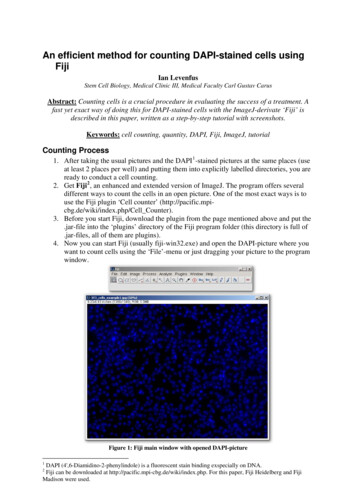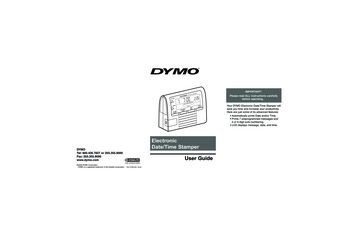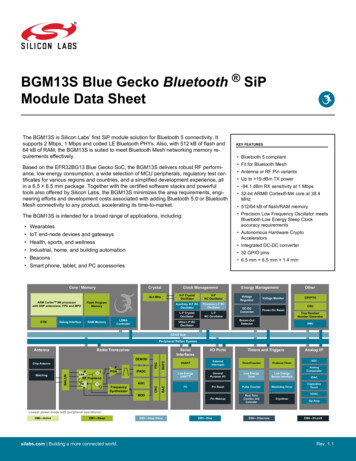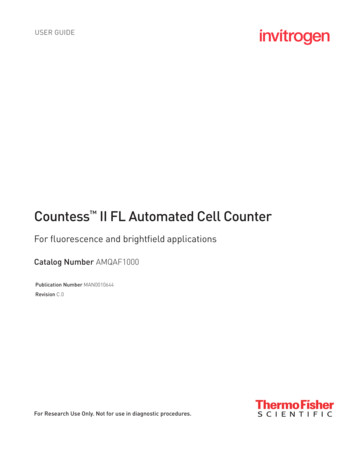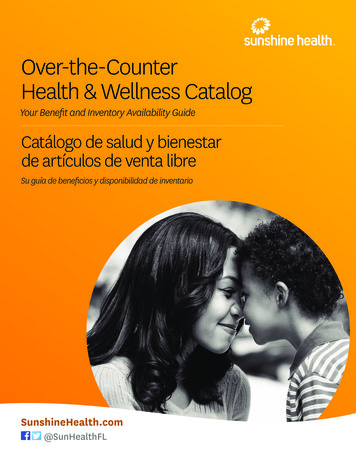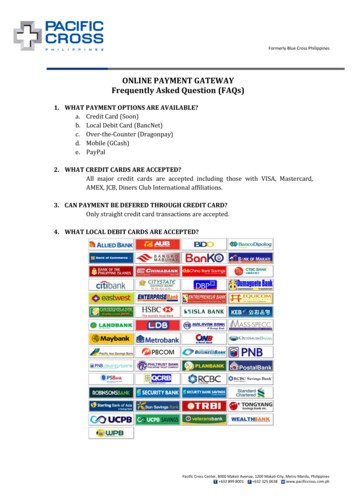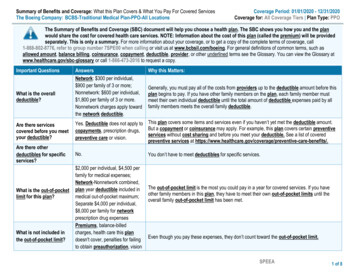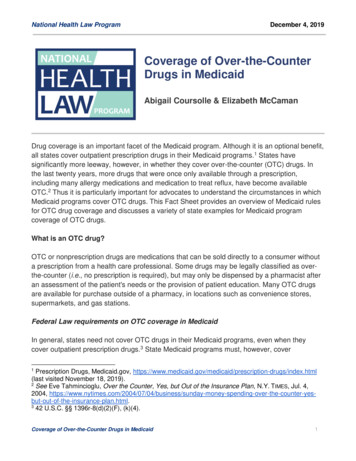
Transcription
National Health Law ProgramDecember 4, 2019Coverage of Over-the-CounterDrugs in MedicaidAbigail Coursolle & Elizabeth McCamanDrug coverage is an important facet of the Medicaid program. Although it is an optional benefit,all states cover outpatient prescription drugs in their Medicaid programs.1 States havesignificantly more leeway, however, in whether they cover over-the-counter (OTC) drugs. Inthe last twenty years, more drugs that were once only available through a prescription,including many allergy medications and medication to treat reflux, have become availableOTC.2 Thus it is particularly important for advocates to understand the circumstances in whichMedicaid programs cover OTC drugs. This Fact Sheet provides an overview of Medicaid rulesfor OTC drug coverage and discusses a variety of state examples for Medicaid programcoverage of OTC drugs.What is an OTC drug?OTC or nonprescription drugs are medications that can be sold directly to a consumer withouta prescription from a health care professional. Some drugs may be legally classified as overthe-counter (i.e., no prescription is required), but may only be dispensed by a pharmacist afteran assessment of the patient's needs or the provision of patient education. Many OTC drugsare available for purchase outside of a pharmacy, in locations such as convenience stores,supermarkets, and gas stations.Federal Law requirements on OTC coverage in MedicaidIn general, states need not cover OTC drugs in their Medicaid programs, even when theycover outpatient prescription drugs.3 State Medicaid programs must, however, cover1Prescription Drugs, Medicaid.gov, gs/index.html(last visited November 18, 2019).2See Eve Tahmincioglu, Over the Counter, Yes, but Out of the Insurance Plan, N.Y. TIMES, Jul. 4,2004, -insurance-plan.html.342 U.S.C. §§ 1396r-8(d)(2)(F), (k)(4).Coverage of Over-the-Counter Drugs in Medicaid1
National Health Law ProgramDecember 4, 2019nonprescription prenatal vitamins and fluoride preparations for pregnant people, and certainnonprescription tobacco cessation products.4 In addition, under the Early and PeriodicScreening, Diagnostic, and Treatment (EPSDT) provisions of the Medicaid Act, state Medicaidprograms should cover nonprescription medications necessary to correct or ameliorate anillness or condition of a beneficiary who is under age 21.5OTC drugs – whether mandatory OTC drugs required by statute or additional OTC drugscovered at state option – are only included under the federal Medicaid program when areprescribed by an authorized prescriber.6 In other words, despite the fact that, by definition, aprescription is not required to purchase these medications, states can only obtain federalMedicaid dollars for OTC drugs if they are prescribed.7 States may also provide OTC drugsthat are not prescribed to their Medicaid beneficiaries with state funds. OTCs that areprescribed by an authorized prescriber fall into two categories.First, some OTC drugs are considered “covered outpatient drugs” under the Medicaid Act.When an OTC drug is prescribed and meets criteria to be considered a “covered outpatientdrug” under the Medicaid Act, it is treated as a “covered outpatient drug,” and the otherstatutory conditions that apply to such drugs apply.8 CMS has established the following criteriafor covered outpatient drugs:1. It is an FDA-approved prescription drug, biological product, or insulin as defined bystatute with an FDA-assigned National Drug Code (NDC);2. It is not dispensed as part of inpatient hospital services, hospice services, dentalservices (with limited exceptions), physicians’ services, outpatient hospital services,nursing facility services and services provided by an intermediate care facility, otherlaboratory and x-ray services, or renal dialysis;3. It is prescribed for a medically accepted indication, as defined by statute; and4. The manufacturer has entered a rebate agreement with CMS.9442 U.S.C. §§ 1396r-8(d)(2)(E), (d)(7)(A).Id. § 1396d(r)(5).6Id. §§ 1396r-8(k)(4); DMDL, Defining a “Prescribed Drug” and a “Covered Outpatient Drug” 4 (Oct. 5,2016) (No. 178) [hereinafter DMDL No. 178], Releases/State-Releases/state-rel-178.pdf7Defining a “Prescribed Drug” and a “Covered Outpatient Drug” 4 (Oct. 5, 2016) (No. ds/Rx-Releases/State-Releases/state-rel-178.pdf842 U.S.C. §§ 1396r-8(k)(4); see Michelle Lilienfeld, Nat’l Health Law Prog., Medicaid OutpatientPrescription Drugs (2016) (describing the requirements for drug coverage in Medicaid -medicaid-outpatient-prescription-drugs.942 C.F.R. 447.502; see also DMDL No. 178, supra note 6, at 4.5Coverage of Over-the-Counter Drugs in Medicaid2
National Health Law ProgramDecember 4, 2019Federal regulations therefore explicitly exclude “[a]ny drug product prescription or over-thecounter (OTC), for which an NDC number is not required by the FDA; [and o]ver-the-counterproducts that are not drugs” from the definition of covered outpatient drugs.10Second, other OTC drugs may be covered in Medicaid when as “prescribed drugs.” Suchdrugs need not meet the above criteria for “covered outpatient drugs.” Prescribed drugs mayinclude OTC drugs whose manufacturer has not entered a rebate agreement with CMS or thatdo not have an NDC number provided by the FDA. In guidance, CMS has described“prescribed drugs” as the larger category of drugs for which federal Medicaid funds areavailable, which includes, but is not limited to, “covered outpatient drugs,” stating that:“‘covered outpatient drugs’ are a subset of prescribed drugs.”11 The concept of a prescribeddrug is defined in regulation as:[S]imple or compound substances or mixtures of substances prescribed for the cure,mitigation, or prevention of disease, or for health maintenance that are - (1) Prescribedby a physician or other licensed practitioner of the healing arts within the scope of th[eir]professional practice as defined and limited by Federal and State law; (2) Dispensed bylicensed pharmacists and licensed authorized practitioners in accordance with the StateMedical Practice Act; and (3) Dispensed by the licensed pharmacist or practitioner on awritten prescription that is recorded and maintained in the pharmacist's or practitioner'srecords.12CMS has also clarified that “a product [that] meets the regulatory definition of ‘prescribed drug’. . may be covered by a state, and is eligible for [federal Medicaid funds]. . . . even if it is not a‘covered outpatient drug.’”13 Thus, states may, but are not required to, cover a broad range ofOTC medications in their Medicaid programs as long as they meet the regulatory criteria.State ExamplesWhile most coverage of OTC drugs is optional for states, the majority (42 jurisdictions in 2018)take up the option.14 Several states (18 jurisdictions) limit which OTC medications are coveredin their Medicaid programs, and many (18) also impose other limitations such as priorauthorization, quantity limits, or step therapy requirements.15 In order to obtain federalMedicaid funds, states must limit coverage of OTC drugs to those prescribed by an authorized1042 C.F.R. § 440.502(3).DMDL No. 178, supra note 6, at 4.1242 C.F.R. § 440.120(a).13DMDL No. 178, supra note 6, at 4.14See Kaiser Fam. Found., Medicaid Benefits: Over-the-Counter /medicaid-benefits-over-the-counter-products (last visited Nov.22, 2019).15See id.11Coverage of Over-the-Counter Drugs in Medicaid3
National Health Law ProgramDecember 4, 2019provider, which can serve as a barrier to care as consumers must take the additional step ofconsulting a prescriber before obtaining the medication they need. Nonetheless, multiplemodels for access have emerged and continue to evolve as advocates push for a deliverysystem that best serves low-income enrollees.Access to OTC contraceptionFederal Medicaid law requires states to cover “family planning services and supplies” withoutcost-sharing.16 As with most other Medicaid services, states have some discretion to determinewhat family planning services and supplies to cover in their programs, as long the coverage is“sufficient in amount, duration, and scope to reasonably achieve its purpose.”17 There arecurrently five FDA-approved contraceptive methods available OTC: male/external condom,female/internal condom, spermicide, sponge with spermicide, and levonorgestrel emergencycontraception (EC). Notably, federal Medicaid law does not explicitly require coverage of OTCcontraceptives and coverage varies widely by state and eligibility pathway.Additionally, the most common form of utilization control for OTC contraception in Medicaid isa prescription requirement.18 As of 2016, of the 35 state Medicaid programs that coverlevonorgestrel EC, 27 require a prescription.19 The programs that reportedly allow coverage ofthis method without a prescription are Georgia (for enrollees under 17), Illinois (3 dose limit pervisit), Maryland, Minnesota (maximum of 3 packs per dispensing), Nebraska, New York (up to6 times per year), Oregon, and Washington.20 Of the 30 programs that reported coverage ofnon-EC OTC contraception, 22 require a prescription in all situations.21 The states reportingcoverage without a prescription include Illinois, Indiana, Maryland, Minnesota, Mississippi(internal/female and external/male condoms for family planning waiver enrollees as a medicalclaim), Nebraska, Oregon, and Texas (external/male condoms and spermicide dispensed byfamily planning agencies).221642 U.S.C. §§ 1396d(a)(4)(C), (10); 42 C.F.R. § 447.56(a)(2)(ii) (prohibiting imposition of cost-sharingfor family planning services and supplies). States do not have to cover family planning services andsupplies for individuals who qualify for Medicaid due to their status as medically needy. See also 42U.S.C. § 1396o(a)(2)(d).1742 C.F.R. § 440.230(b); CMS, STATE MEDICAID MANUAL § 4270.B.18See Kaiser Fam. Found., Medicaid Coverage of Family Planning Benefits: Results from a StateSurvey, tate-Survey (last visited Nov. 22, 2019).19Id.20Id. See also Wash. State Health Care Auth., Washington Apple Health (Medicaid): Prescription DrugProgram Billing Guide 31, 36, 47 (2019), /prescription-drug-bg-20191001.pdf.21See Kaiser Fam. Found., supra note 18.22Id.Coverage of Over-the-Counter Drugs in Medicaid4
National Health Law ProgramDecember 4, 2019Medicaid benchmark benefits for the expansion population must incorporate Essential HealthBenefits (EHBs).23 Federal regulations require the EHB to include coverage of all preventiveservices required under the ACA, including at least one form of contraception in each of the 18FDA-approved contraceptive method categories for women.24 This means that at least oneform of male/external condom, female/internal condom, spermicide, sponge with spermicide,and levonorgestrel emergency contraception, all of which are available OTC, must be coveredin Medicaid alternative benefit plans, but a prescription may still be required.25Some states have gone beyond federal coverage requirements by passing progressiveContraceptive Equity laws. The scope of coverage under Contraceptive Equity laws varies bystate, but specifically apply to OTC contraceptives in the state Medicaid program in Delawareand Washington, DC. In Delaware, coverage of levonorgestrel EC without a prescription isrequired in Medicaid.26 Alternatively in DC, coverage of all OTC contraceptives is required inMedicaid, but prescription requirements are not clear.27Pharmacist prescribingThe media often refers to state pharmacist prescribing laws as creating OTC access. 28However, OTC status is a federal FDA designation. Additionally, federal law requires all writtenMedicaid prescriptions for outpatient drugs, whether handwritten or computer-generated, to betamper-resistant in order for them to be reimbursed, further complicating OTC access.29States, nonetheless, have the power to determine scope of practice, namely who can write aprescription and who can dispense medications. While state pharmacist prescribing laws donot create true OTC access, they do allow pharmacists to prescribe certain drugs thatpreviously could only be accessed through a physician. For example, in California pharmacistscan now prescribe self-administered hormonal birth control, naloxone, pre- and post-exposureprophylaxis, nicotine replacement products, flu shots, and travel medications in certainjurisdictions.30 Pharmacists can also prescribe certain OTC contraceptives in some2342 C.F.R. § 440.347.45 C.F.R. § 156.115(a)(3).25Dep’ts of Labor, Health & Human Servs., & Treasury, FAQs About Affordable Care ActImplementation (Part XXVI) (2015), xvi.pdf.26DEL. CODE ANN. tit. 18, § 3342A.27D.C. CODE § 31-3834.02.28See, e.g., Leanne Shinkle, Over-the-Counter Birth Control Coming to West Virginia, WSAZNEWSCHANNEL 3, June 10, 2019, tml.2942 U.S.C. § 1396b(i)(23).30CAL. BUS. & PROF. CODE §§ 4052(a)(10), 4052.01.24Coverage of Over-the-Counter Drugs in Medicaid5
National Health Law ProgramDecember 4, 2019jurisdictions, namely levonorgestrel EC, which allows enrollees to use insurance coverage forthis OTC product when purchased from a pharmacy counter.31Pharmacist prescribing is a growing state trend, and payment for pharmacist services is criticalto the success of this access model. CMS encourages states to consider using pharmacyaccess models to promote access.32 Federal guidance makes clear that state Medicaidprograms have the flexibility to expand the scope of services for which pharmacists canreceive reimbursement, including dispensing drugs based on independently initiatedprescriptions.33 Yet only a handful of states require Medicaid coverage of pharmacistprescribed drugs.In California, legislation authorizes pharmacists to enroll as Medicaid providers and receivereimbursement for furnishing travel medications, naloxone hydrochloride, nicotine replacementtherapy, and self-administered hormonal contraception, initiating and administeringimmunizations, and providing tobacco cessation counseling.34 Despite the already low MediCal reimbursement rates, the legislation requires the rate of reimbursement for pharmacistservices to be at 85% of the fee schedule for physician services.35Other states have narrowly expanded pharmacist prescribing, and consequently pharmacistcounseling reimbursements in Medicaid, only for contraceptive services. In Oregon, Medicaidbegan directly reimbursing pharmacies for contraceptive claims in July 2017.36 Since then,10% of all new oral and transdermal contraceptive prescriptions were written by pharmacists,and nearly 74% of those patients had not used any form of prescribed birth control in the priormonth.37 In Maryland, both Medicaid and CHIP must provide coverage to pharmacists forcontraceptive services.38 Similarly in DC, Medicaid reimbursement to a pharmacist for selfadministered hormonal contraception is determined by regulation.3931Id. § 4052(a)(10)(A)(1).CMCS, State Flexibility to Facilitate Timely Access to Drug Therapy by Expanding the Scope ofPharmacy Practice using Collaborative Practice Agreements, Standing Orders or Other PredeterminedProtocols (2017), ownloads/cib011717.pdf.33Id.34CAL. W ELF. & INST. CODE § 14132.968(b)(1).35Id. § 14132.968(a)(3).36Ass’n of State & Territorial Health Officials, Oregon Authorizes Pharmacists to Prescribe HormonalBirth Control (2017), rescribe-Hormonal-Birth-Control/.37Lorinda Anderson et al., Pharmacist Provision of Hormonal Contraception in the Oregon MedicaidPopulation, 133 OBSTETRICS & GYNECOLOGY 1231 (June 2019).38MD. CODE ANN., HEALTH GEN. § 15-148(c).39D.C. CODE § 3-1202.08(g-1)(3).32Coverage of Over-the-Counter Drugs in Medicaid6
National Health Law ProgramDecember 4, 2019Finally, a small number of states have implemented Medicaid-covered pharmacist prescribingonly for emergency contraception, due to the time-sensitive nature of the medication. InMassachusetts, Medicaid requires coverage of levonorgestrel EC without a prescription whendispensed by a pharmacist.40 In New Mexico, Medicaid can pay for levonorgestrel EC as eithera prescription or OTC drug, although the term OTC may be misleading in this context sinceboth options require pharmacy claims.41ConclusionThis Fact Sheet has provided an overview of Medicaid OTC drug coverage rules, andexamples of how states have provided access to OTC drugs in their Medicaid programs. Forin-depth information, advocates should check federal transmittals and guidance documents,and state law. In addition, advocates should look at court decisions that address how theMedicaid requirements have been interpreted and state efforts to expand or restrict MedicaidOTC drug coverage and access. Please visit our website at healthlaw.org for further MedicaidOTC drug publications and updates.40MASS. GEN. LAWS ch. 118E, § 10K.N.M. Human Servs. Dep’t, Med. Assistance Program Manual Supplement 09-05 nts/EC-OTC%20Medicaid%20Supplement.pdf.41Coverage of Over-the-Counter Drugs in Medicaid7
in their Medicaid programs, and many (18) also impose other limitations such as prior authorization, quantity limits, or step therapy requirements.15 In order to obtain federal Medicaid funds, states must limit coverage of OTC drugs to those prescribed by an authorized 10 42 C.F.R. § 440.502(3). 11 DMDL No. 178, supra note 6, at 4.



